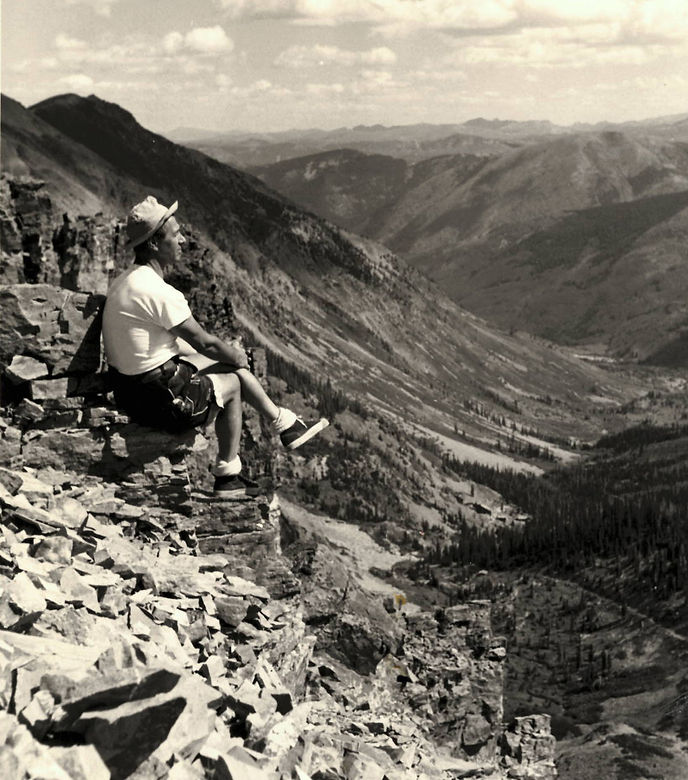
head+heart+hand
When Lynda Resnick calls Herbert Bayer "Leonardo Da Vinci for the 20th century" she's referring to the amazing scope and quality of his work. Over his 66-year career, the Austrian-born, Colorado artist excelled in multiple disciplines including painting, graphic design, typography, architecture, and sculpture.
His decision in 1946 to leave New York, the center of the US art world, for a semi-abandoned mining town high in the Colorado Rockies was the best choice for his sanity, but not for his legacy.
A colorado-based team of filmmakers led by granddaughter, Denver-based artist Koko Bayer, aims to change that. They are currently in pre-production on a feature-length documentary film showcasing his groundbreaking work.
Titled head+heart+hand exploring the genius of herbert bayer, it will be the first comprehensive documentary series on Bayer's amazing 66-year career. Combining Bayer’s techniques of “visual communication” with interviews with contemporaries and scholars to show the impact he’s had on our world.
in addition to our fiscal sponsor Aspen Film, the RiNo Art District, RedLine Contemporary Art Center, and Colorado Film Commission have all been instrumental in getting this important project started.
For more information please contact: herbertbayerdocumentary@gmail.com

This documentary will showcase the groundbreaking work of Austrian/American artist Herbert Bayer, a "20th Century Leonardo " who excelled in multiple disciplines including painting, graphic design, sculpture, typography, exhibition design, and architecture over his 66-year career.

Bayer's decision to leave the center of the US art world for a semi-abandoned mining town high in the Colorado Rockies was the best choice for his sanity, but not for his legacy.
A biography on the Museum of Modern Art's site lists his achievements at the Bauhaus and in New York but when it comes to his work after leaving the city in 1946 it only states that he "worked as a graphic designer for the remainder of his career." In fact, it was the beginning of the most prolific artistic period of his life. Over the next 39 years, he would help make Aspen an international center for art, ideas, and outdoor recreation, revolutionize the presentation of information and data with his landmark World Geographic Atlas, build the campus of the Aspen Institute and create an amazing body of sculptures and paintings.

Our goal is to make the first comprehensive documentary on Herbert's amazing 66-year career. Combining Herbert’s techniques of “visual communication” with interviews with contemporaries and scholars to show the impact he's had on our world.
about the project

This documentary series will be a comprehensive overview of the groundbreaking work of Austrian/American artist Herbert Bayer. Linda Resnick calls him a "20th Century Leonardo Da Vinci" who excelled in multiple disciplines including painting, graphic design, sculpture, typography, exhibition design, and architecture over his 66-year career.

In 1921, after Hearing Stories of a revolutionary new art school in Weimar, Germany, he quit his job and hiked 150 miles to seek admission. Impressed by his talent and determination, Bauhaus founder Walter Gropius admitted him despite it being halfway through the semester.

At the Bauhaus, he studied with his heroes and colleagues, absorbing their lessons while forging his own path.

Just 4 years after his arrival, at the age of 25, he was appointed to the faculty of the most influential art school of the 20th century: joining a group that included: Ani & Joseph Albers, Marcel Breuer, Vassily Kandinsky, Paul Klee, Lyonel Feininger, László Moholy-Nagy, and Walter Gropius.

In 1925 Bayer designed "Font Universal" whose clean, sans serif design influenced every modern font that came after it. His 1927 cover for Bauhaus Magazine introduced his new theories of graphic design that, according to Alexander Dorner, "revolutionized the designing of magazine covers to such a degree that its philosophy has become common property."

During his time at the Bauhaus, he developed his multiplane theory of exhibition design which has gone on to be universally adopted.

In 1928 he moved to Berlin to put the ideas he had been developing into practice. He combined photomontage with his concepts for "visual communication" and quickly became one of the leaders of modern graphic and exhibition design in Europe.

His world began to collapse as Hitler's grip on Germany tightened in the mid 1930's. The government steadily took control of all media until there was only one client and you had no choice but to work for them or leave. Bayer's modernist ideas were not in step with the government but leaving was becoming increasingly difficult. In 1938 he lost his Austrian citizenship and his art was included in the notorious "Entartete Kunst" (degenerate Art) show. It was clearly time to go.

The opportunity came when his Mentor Walter Gropius hired him to design the landmark Museum of Modern Art show "Bauhaus 1919-1928" which introduced the Bauhaus to the USA in 1938. With the help of his wife Irene, he gathered his work and that of many of his Bauhaus colleagues and fled to New York.

His ideas of graphic and exhibition design were immediately embraced in New York. His work appeared on the covers of magazines including Vogue, Harpers, and Fortune and he designed notable exhibitions "Road to Victory" and his groundbreaking "Airways to Peace" for the Museum of Modern Art. His work influenced designers and artists from Bass to Warhol.

Despite his success, he hated city life. In late 1945 friend and client, Walter Paepcke invited him to come to a nearly abandoned mining town high in the Colorado Rockies to help transform it into a world-class ski destination and then into a center for ideas and art.

It would be the beginning of the most prolific artistic period of his life. Over the next 40 years, he would help make Aspen an international center for art, ideas, and outdoor recreation, revolutionize the presentation of information and data with his landmark World Geographic Atlas, build the campus of the Aspen Institute and create the World's first earthwork.

Regardless of how busy he was with other projects, he painted daily, creating an amazing body of paintings and sculptures. These works serve as the spine of our documentary, showing how they both influenced and were influenced by his many other projects.

Absenting himself from the New York art world meant that his work is less known than that of his peers. This documentary will present the full picture of his 65-year career and show the profound impact he has had on our world.
Resnick Center for
Herbert Bayer Studies

Something amazing happened this past summer when the Resnick Center for Herbert Bayer Studies opened on the campus of the Aspen Institute. The world-class center was made possible through a major gift from Lynda and Stewart Resnick, co-owners of The Wonderful Company. The mission of the is The Bayer Center is to commemorate and contextualize the legacy of Herbert Bayer.
“Herbert Bayer’s work and legacy, and his tremendous impact on Aspen, will no longer go underappreciated,” said Lynda Resnick. “To see his many artistic accomplishments recognized in this beautiful, world-class Center is a special moment. It’s wonderful that Bayer’s influence will be accessed by new audiences and celebrated for years to come.”
Note: All of the interviews, footage, and research material we collect will be available to researchers in the future with the help of the Bayer Center and the DPL Western History Archive.


